Photography
Kigen Munakata – sangu to Munakata – ichizoku
Origin – Shrine of Munakata – Sangu and Munakata clan
起源 〜宗像三宮と宗像一族〜
Mysteries of the Heritage in the “Sacred Island of Okino-shima and Associated Sites in the Munakata Region”.
Okino-shima island is called as “the isle inhabited by divinity”. There are no inhabitants other than a solitary priest who conducts sacred rituals. The island is protected by strict taboos, such as the prohibition of women, a mandatory ritual purification in the sea prior to landing, and a ban on the removal of any natural items. This portfolio traces the mysteries of the ancient faith of this restricted island.
The island is strictry protected by many taboos, especially the prohibition for women to approach there, or mandatory of the ritual purification in the sea before landing, prohibition of taking away anything, as trees, grasses, or stones from there. This is a series of Works, traced and focused on the mysteries of the ancient faith in this prohibited island.
(In 2017, Sacred Island of Okino-shima and Associated Sites in the Munakata Region were registered as UNESCO World Heritage Sites).
-
沖ノ島
Okino-shimaOkino-shima Island
沖ノ島
Okino-shimaOkino-shima Island
-

神宿る島
Kami-yadoru-shimaSacred Island

神宿る島
Kami-yadoru-shimaSacred Island
General visit of this island is prohibited because the island itself is considered as divine corpus.There founded one of the Munakata-Sangu shrine. Here remains the form of Japanese-style worship of nature almost in its original form, and 23 ritual sites have been discovered there.
-

沖ノ島
Okino-shimaOkino-shima Island

沖ノ島
Okino-shimaOkino-shima Island
Taken from behind the island. There grows a primeval forest on a large cliff.
-

飛び石
Tobi-ishistepping stones

飛び石
Tobi-ishistepping stones
Large and small stepping stones are placed regularly as the main approach to Okitsu-miya.
-

沖津宮
Okitsu-miyaOkitsu-miya Shrine

沖津宮
Okitsu-miyaOkitsu-miya Shrine
Taken from inside of Okitsu-miya. The shrine is surrounded by huge rocks and primeval forests.
-

沖津宮(背面)
Okitsu-miyaOkitsu-miya Shrine (side behind)

沖津宮(背面)
Okitsu-miyaOkitsu-miya Shrine (side behind)
The shrine is settled quietly between large rocks in the forest. The entire island is as the precincts, sacred area of Okitsu-miya.
-

岩陰祭祀跡 5世紀後半〜7世紀
Iwakage-saishi-atoRitual site of the huge rock shade (late 5th to 7th century)

岩陰祭祀跡 5世紀後半〜7世紀
Iwakage-saishi-atoRitual site of the huge rock shade (late 5th to 7th century)
One of the reside of ancient ritual sites on Okino-shima. In a huge rock shade is as a ritual place, to feel a close relationship with nature.
-

巨石
KyosekiHuge rocks

巨石
KyosekiHuge rocks
Around the approach to Okitsu-miya, there are also huge rocks as in an ancient time.
-

巨石の間
Kyoseki no AidaBetween huge rocks

巨石の間
Kyoseki no AidaBetween huge rocks
The power of nature is everywhere on the island.
-

岩上祭祀跡 4世紀後半〜5世紀
Ganjo-saishi-atoRitual site on the rock (late 4th – 5th century)

岩上祭祀跡 4世紀後半〜5世紀
Ganjo-saishi-atoRitual site on the rock (late 4th – 5th century)
It is considered as the oldest form of ritual. A ritual space is settled on the rock, and the enormous rock serves as a subject of possession (yorishiro) to invoke the divine spirits.
-

古代祭祀の奉献品等
Kodai-saishi no HokenhinVotive Offerings of ancient rituals, etc.

古代祭祀の奉献品等
Kodai-saishi no HokenhinVotive Offerings of ancient rituals, etc.
Votive Offerings are placed everywhere in and around the ritual space. Proof of the observation to an ancient taboo.
-
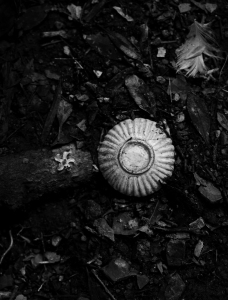
古代祭祀の奉献品
Kodai-saishi no HokenhinVotive Offerings of ancient rituals, etc.

古代祭祀の奉献品
Kodai-saishi no HokenhinVotive Offerings of ancient rituals, etc.
There remain Votive Offerings as untouched for the proof of the observation to an ancient taboo.
-

耳石
Mimi-ishiEar-shaped stone

耳石
Mimi-ishiEar-shaped stone
A stone shaped like an ear due to an erosion over a long period of time.
-

原生林
GenseirinPrimeval forest

原生林
GenseirinPrimeval forest
Most of Okino-shima is deeply covered with primeval forest, and the roots of trees crawling in all directions. There is an ancient prohibition against taking anything, such as tree branches, grass, and stones, out of island and it is still strictly observed.
-

出土神宝 金銅製龍頭(国宝)
Shutsudo-Shinpo Kondo-sei RyutoExcavated treasure of sacred, Dragon Head made by gilt bronze (designated as a National Treasure of Japan)

出土神宝 金銅製龍頭(国宝)
Shutsudo-Shinpo Kondo-sei RyutoExcavated treasure of sacred, Dragon Head made by gilt bronze (designated as a National Treasure of Japan)
A decoration used at the tip of a banner pole for hanging flags and woven hats during rituals.
Since 1954, there have been conducted scientific surveys three times on Okino-shima, and excavated 80,000 sacred treasures as a result. All of these sacred treasures are designated as national treasures.
-
大島
O-shimaO-shima Island
大島
O-shimaO-shima Island
-
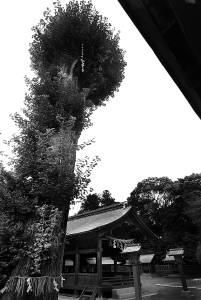
中津宮とご神木
Nakatsu-miya to GoshinbokuNakatsu-miya shrine and Sacred tree

中津宮とご神木
Nakatsu-miya to GoshinbokuNakatsu-miya shrine and Sacred tree
Nakatsu-miya is dedicated to Tagitsuhime-no-Kami, one of the three Goddesses of Munakata, which located on O-shima, 10 kilometer distant from the mainland of Munakata. The enormous ginkgo tree in front is a Sacred tree which lives more than 400 years.
-

鳥居
ToriiSanctuary main entrance

鳥居
ToriiSanctuary main entrance
A uniquely shaped Torii dedicated by a fisherman who was grateful that he was saved from drowning twice during his fishing.
-

沖津宮遙拝所
Okitsu-miya YohaisyoPlace for ritual prayers to Okitsu-miya

沖津宮遙拝所
Okitsu-miya YohaisyoPlace for ritual prayers to Okitsu-miya
A place of worship at Okitsu-miya on the north side of O-shima. Which serves as a worship place for Okino-shima, where is prohibited landing as a sanctuary.
-

沖津宮遥拝所社殿内
Okitsu-miya Yohaisyo Shaden-naiInside of the shrine Okitsu-miya Yohaisho

沖津宮遥拝所社殿内
Okitsu-miya Yohaisyo Shaden-naiInside of the shrine Okitsu-miya Yohaisho
It can be seen Okino-shima far beyond the Genkai-Sea on sunny days.
-

大島祇園山笠
O-shima Gion YamakasaO-shima Gion Yamakasa Festival

大島祇園山笠
O-shima Gion YamakasaO-shima Gion Yamakasa Festival
Its origin should be back to the Edo period (17-19 century). Each district has a decorated vehicle for the feast and carry it and rush into the sea. Pray for the exorcism of epidemics (prayer for healthy life without illness) and large amount of fishing.
-
辺津宮(総社)
Hetsu-miya (So-sha)辺津宮(総社)
Hetsu-miya (So-sha) -
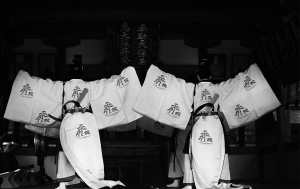
春季大祭 主基地方風俗舞
Syuki-taisai Shukichiho-fuzoku-maiDance of Suki Regional Customs at Spring Grand Festival

春季大祭 主基地方風俗舞
Syuki-taisai Shukichiho-fuzoku-maiDance of Suki Regional Customs at Spring Grand Festival
A dance specially bestowed on the occasion of Emperor Showa's enthronement. According to a legendary divine decree, the Imperial lineage and Munakata-Taisha shrine have had a deep relationship since ancient times.
* The Niigata, Nagano, and Shizuoka lines divide Japan into east and west, and the area west of these three prefectures is called the Suki region. -
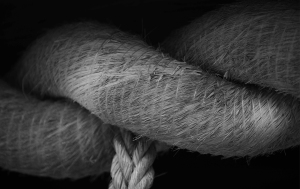
注連縄
ShimenawaSacred rope

注連縄
ShimenawaSacred rope
Shimenawa rope is a boundary sign which separates the divine realm from the secular world. Shimenawa rope of Hetsu-miya is fixed with fishline.
-

辺津宮境内
Hetsu-miya KeidaiPrecincts of Hetsu-miya

辺津宮境内
Hetsu-miya KeidaiPrecincts of Hetsu-miya
Hetsu-miya is leading shrine of the Munakata-taisya complex. Passing through the Shin-mon gate, there stands the worship hall for prayers, and behind that is the main shrine where goddess Ichikishima-hime resides. The gate is decorated with a chrysanthemum emblem, the symbol of Munakata Taisha shrine.
-
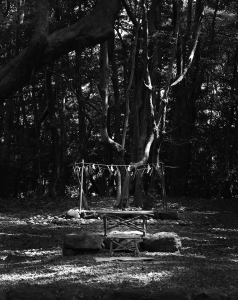
高宮斎場
Takamiya-saijouTakamiya-saijou is Ancient Ritual Space

高宮斎場
Takamiya-saijouTakamiya-saijou is Ancient Ritual Space
Takamiya-saijou which located in deep inside of the precincts is reminiscent of an ancient ritual with no architectural structures. According to the tradition, here is the place where goddess Ichikishima-hime descended.
-

月次祭 高宮斎場
Tsukinami-sai Takamiya-saijouMonthly rituals at Takamiya-saijou

月次祭 高宮斎場
Tsukinami-sai Takamiya-saijouMonthly rituals at Takamiya-saijou
Preserving the ancient forms, preside the rituals on the 1st and 15th of every month at the Takamiya-saijou, with offerings and prayers.
-

玉串
TamagushiA branch of a sacred tree

玉串
TamagushiA branch of a sacred tree
Tamagushi is considered to have the same effect as offerings to the Kami (rice, sake, fish, vegetables, fruits, salt, water, etc.).
-
新原・奴山古墳群
Shinbaru Nuyama Kohun-gun新原・奴山古墳群
Shinbaru Nuyama Kohun-gun -
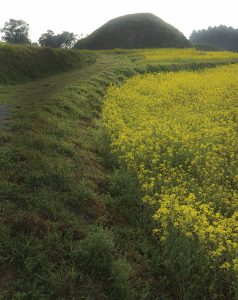
新原・奴山古墳群
Shinbaru Nuyama Kohun-gun
新原・奴山古墳群
Shinbaru Nuyama Kohun-gunA group of ancient burial mounds built between the 5th and 6th centuries. Here buried the Munakata clan, local ruler and oversea trader at that time, and who presides rituals on Okino-shima. Now, one of the UNESCO World Heritage Sites.
-

新原・奴山古墳群
Shinbaru Nuyama Kohun-gun
新原・奴山古墳群
Shinbaru Nuyama Kohun-gunA group of ancient burial mounds built between the 5th and 6th centuries. Here buried the Munakata clan, local ruler and oversea trader at that time, and who presides rituals on Okino-shima. Now, one of the UNESCO World Heritage Sites.
-

新原・奴山古墳群
Shinbaru Nuyama Kohun-gun
新原・奴山古墳群
Shinbaru Nuyama Kohun-gunA group of ancient burial mounds built between the 5th and 6th centuries. Here buried the Munakata clan, local ruler and oversea trader at that time, and who presides rituals on Okino-shima. Now, one of the UNESCO World Heritage Sites.
Click on the photo to see the individual portfolios.
